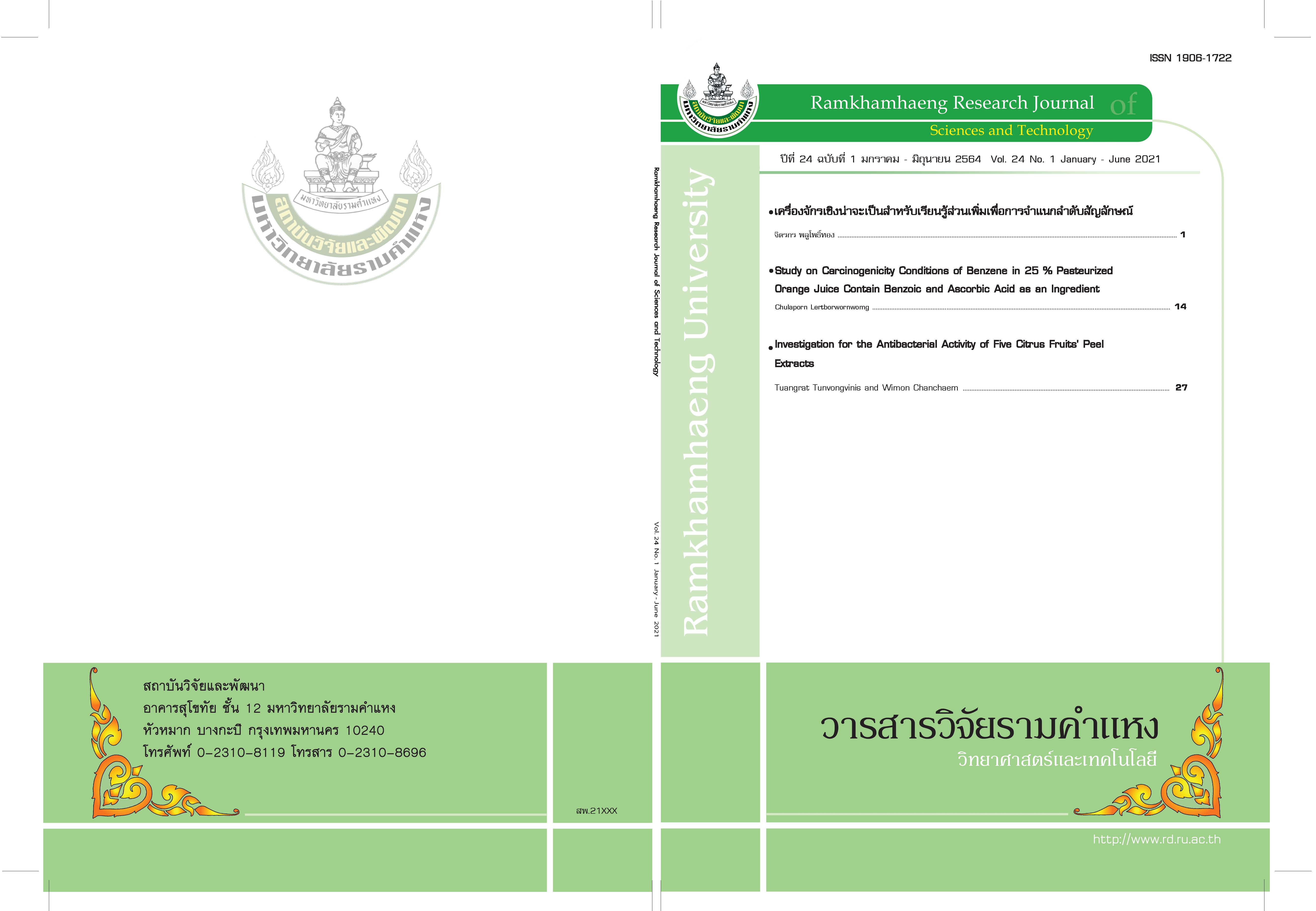Study on the Conditions for Emerging of Carcinogenic Benzene in Pasteurized 25 % Orange Juice Containing Benzoic and Ascorbic Acid
Main Article Content
Abstract
The objective of this experiment was to study the possibility of benzene formation at different
conditions used in pasteurized 25% orange juice production and storage : benzoate or ascorbic acid alone,
benzoate and ascorbic acid together, pH, heating temperature and time, storage conditions(temperature, time
and light exposure),metal ions and chelating agents were studied to determine how high of benzene could
be formed if starting from one optimum condition for benzene formation until all conditions are optimized
then we will know what factors play a major role to reduce benzene level within safety limit . An addition
of 200 ppm sodium benzoate and 120 ppm ascorbic acid to 25% orange juice, pH 3.7, pasteurized at 100
OC 10 min, stored at 30 OC 24 hrs., did not induce benzene formation. The amount of benzene increased
from 0 at pH 3.7 (commercial practice) to 5.6 ppb at pH 2. Increased processing temperature from 90 OC to
100 OC for 20 minutes, found benzene increased from 0 to 8.82 ppb and processing time from 10 to 20
minutes at 100 OC, found benzene increased from 5.32 to 8.82 ppb. Higher storage temperature caused
more benzene formation than longer storage time. Light exposure did not increase benzene formation
. Benzene formation in product added only sodium benzoate or ascorbic acid was less than sodium benzoate
together with ascorbic acid (stored at 45 OC). The addition of chelating agent (disodium EDTA and sodium
hexametaphosphate, SHMP) can decrease benzene formation.
Article Details
Ramkhamhaeng University
References
Benzoate in Model Systems by Proton Transfer Reaction-Mass Spectrometry, International J. of
Mass Spectrometry. 275(1-3): 117–121.
ATSDR (Agency for Toxic Substances and Diseases Registry). 2018. Toxic Substance Protal : Benzene(CAS
ID # : 71-43-2). https://www.atsdr.cdc.gov/substances/toxsubstance.asp?toxid=14.
Casado, F.J., Sanchez, A.H., de Castro, A., Rejano, L., Beato, V.M. and Montano, A. 2011. Fermented
Impact of Additives on Quality Parameters,” J. of Agricultural and Food Chemistry. 59(6): 2403-
2409.
Central Laboratory (Thailand) Co.,Ltd., 2010. In House Method based on J. of. Chromatography A1035
(2004) 17-22 and detected by GC/MS with Headspace Technique.
Chang, C. and Ku, K. 1993. Studies on Benzene Formation in Beverages. J. of Food and Drug Analysis. 1 :
385-393.
Codex Alimentarius, FAO/WHO Foods Standards. 2017. Food Additive Group Details : Phosphates
. http://www.fao.org/gsfaonline/groups/details.html?id=18).
Cvetkovic, B.R. and Jokanovic, M.R. 2009. Effect of Preservation Method and Storage Condition on Ascorbic
Acid Loss in Beverages. BIBLID: 1450-7188. 40,1-7.
Dos Santos, V.P.S., Salgado, A.M., Torres, A.G. and Pereira, K.S. 2015. Review Article: Benzene as a
Chemical Hazard in Processed Foods. International J. of Food Science., p. 1-7
FDA (Food and Drug administration). 2013. Notification of the Ministry of Public Health (No.356) on Beverage
in Sealed Container, Ministry of Public Health, Thailand.
Gardner, L. K. and Lawrence, G. D. 1993. Benzene production from decarboxylation of benzoic acid in the
presence of ascorbic acid and a transition-metal catalyst. J. of Agricultural and Food Chemistry.
41(5): 693-695.
Igoe, R.S. and Hui, Y.H. 2001. Dictionary of Food Ingredients 4th ed. USA: An Aspen Publication. In House
Method based on J. of Chromatography A 1035 (detected by GC/MS with Headspace Technique.
2004. 17-22.
IARC (International Agency for Research on Cancer). 2018. IARC Monographs on the Evaluation of
Carcinogenic Risks to Humans. World Health Organization http://monographs.iarc.fr/ENG/Classification/.
Kafkas, E., Kosar, M., Turemis, N. and Baser, K.H.C. 2006. Analysis of Sugars, Organic Acids and Vitamin C
Contents of Blackberry Genotypes from Turkey. Food Chemistry 97 : 732-736.
Lange, M.W., Ommen, J.G.V. and Lefferts.,L. 2002. Deoxygenation of Benzoic Acid on Metal Oxides, 2
. Formation of Byproducts. Applied Catalysis A : General, 231 : 17-26.
Lawrence, J. 2010. Vitamin C : Stability and Quantitative Estimate of L-Ascorbic Acid. http://www.uwsp.edu/
chemistry/jlawrence/Content/Chem%20260%20Content/Chem%20260%20Labs/Vitamin%20C%20
Lab.pdf. University of Wisconsin-Stevens Point.
McNeal, T.P., Nyman, P.J., Diachenko, G.W. and Hollifield, H.C. 1993. Survey of Benzene in Foods by Using
Headspace Concentration Techniques and Capillary Gas Chromatography. J. of AOAC
International. 76 (6) : 1213-1219.
Medeiros, V.R., De, M. B., Andjelkovic, M., Canfyn, M., Van, O.I. and Van, L, J. 2011. Factors Influencing
Benzene Formation from the Decarboxylation of Benzoate in Liquid Model System. J. Agr. Food
Chem. 59(24): 12975-12981.
Morsi, R.M.Y., EL-Tahan, N.R. and El-Tobgy, K. 2012. Probability of Benzene Forming in Egyptian Non-
Alcohol Carbonated Soft Drinks,” Australian J. of Basic and Applied Sciences. 6(3): 271–278.
Nyman, P.J., Wamer, W.G., Begley, T.H., Diachenko, G.W. and Perfetti, G.I. 2010. Evaluation of accelerated
UV and Thermal Testing for Benzene Formation in Beverages Containing Benzoate and Ascorbic
Acid. J. of Food Science. 75(3) : 263-267.
Techakriengkrai, I. and Surakarnkul, R. 2006. The Analysis of Benzoic Acid and Sorbic Acid in Thai Rice
Wines and Distillates by Solid-Phase Sorbent Extraction and High-Performance Liquid
Chromatography. J. of Food Composition and Analysis. 20: 220-225.
William, H. 2002. Official Method of Analysis of AOAC International. 17th ed. Gaithersburg, Md : Washington DC.
http://www.ehow.com/facts 5007478-what-disodium-edta.html. Retrieved March 5, 2010.
http://www.george-eby-research.com/htm/stability-constants.htm.Stability Constants of Various Metal Chelates
. Retrieved January 25, 2011.
https://www.fda.gov/food/ingredientspackaginglabeling/foodadditivesingredients/ucm091048.htm. Food Additive
Status List. U.S. Food & Drug Administration. Department of Health and Human Service.Retrieved
April 20, 2018.


